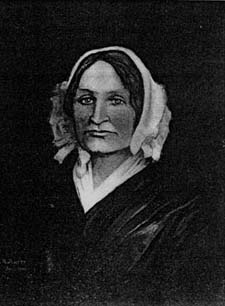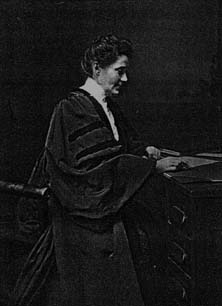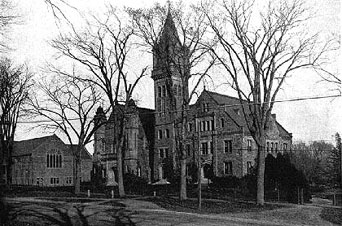Mount Holyoke College
The Famous College over the River Founded by Mary Lyon
Seventy-Five Years Ago
Chapel and Administrative Building
Neighbor to Holyoke, and as the years go, more closely related to the city, is Mount Holyoke College, the famous institution for the education of young women that is rounding out seventy-five years of vitality this month. It is just now preparing to celebrate, in worthy fashion, its three-quarters of a century of life.
Mount Holyoke College dominates all colleges for women because it was the first institution dedicated to the higher education of all women, and because today, after seventy-five years, it proceeds along just the lines laid down for it by its founded, Mary Lyon. In America's Hall of Fame, in New York, there is a niche for Mary Lyon. No woman ever born in America deserves one better, for she stood up before the biased men and women of her time and demanded for women the same educational advantages that were given to men. Then she went ahead and got them for her sisters. First she acquired such education for herself as was obtainable.
Born in the little village of Buckland, in the Franklin County Hills, her own road to learning was over a rough path. But she was the highest type of pioneer, and when her dream of a college for women was ready to take shape she went up and down the land and begged the money that was needed. The original building fund came from 1,800 subscribers. There were two subscriptions of $1,000. Those were the highest. There were three offerings of six cents each. Six cents meant more in 1837 than they do today.
Miss Lyon 's ideal of Mount Holyoke was "a permanent institution consecrated to the work of training young women to the greatest usefulness . . . Designed to be furnished with every advantage that the state of education in this country will allow . . . To put within the reach of students of moderate means such opportunities that none can find better ones."
Miss Lyon was fearfully fought. It was called "chimera-chasing,"
"impractical," "visionary," and anti-Christian. But Miss Lyon kept on, and when the cornerstone of the first building was laid in South Hadley town, she wrote in triumph:
"I have indeed live to see the time when a body of gentlemen has ventured to lay the cornerstone of an edifice which will cost about fifteen thousand dollars, and for an institution for females . . . This will be an era in female education."
When Mount Holyoke Seminary was given its charter by the Legislature of Massachusetts, in 1837, there was but one other college open to women, and that was Oberlin College in Ohio, and that was not for women only.
When Mount Holyoke Seminary was fifty years old, it applied for a change in its name and charter to Mount Holyoke Seminary and College. By this time the old prejudice about women aspiring to college was all gone.

Mary Lyon
|

President Woolley
|
In 1893 the title of seminary was dropped all together, and it became Mount Holyoke College, but has always the same idea and ideal maintained. Mary Lyon's program and purpose are as much alive at Mount Holyoke today as they were at the start. From the first the institution was a great success. Eighty students were present at the opening the first year, and the second year 400 more were declined for lack of room. The original building was enlarged as funds allowed, until in 1865 two wings had been completed and an addition containing gymnasium and laundry built across the ends, thus enclosing a quadrangle. By the generosity of trustees and friends other buildings began to assemble about this quadrangle, until in 1896 there were the library, Lyman Williston Hall, Shattuck Hall, the observatory and two cottages.
On September 27, 1896, ten days after the opening of the college, the old historic building was burned. The first encouragement to rebuild came the next day in the gift of Dr. Pearsons of Chicago, which enabled work to begin at once. The New York Alumnae were almost ready to erect their memorial hall for Miss Brigham, and this was completed before the end of the year. Four other residence halls were ready for use the next September and were all filled to overflowing.
The buildings erected since 1896 are as follows: Mary Brigham Hall, dormitory; Stafford Hall, dormitory; Porter Hall, dormitory; Pearsons Hall, dormitory; Rockefeller Hall, dormitory; Mary Lyon Hall, chapel and administrative building; Mary Ware Wilder Hall, dormitory; gymnasium, Talcott arboretum, Dwight Art building, Elizabeth Mead Hall, dormitory; library; Judson Smith Hall, dormitory; the president's house; Peterson Lodge house for retired and active members of the faculty Building, and Cowles Lodge, dormitory.
In 1837 there were the faculty a principal and associate principal, two instructors, and three assistants who were also pupils, with eighty students. In 1896 the faculty numbered thirty-eight, and the students 331. The curriculum contained 129 different courses and about two-thirds of the work required for a degree was prescribed. Courses in experimental psychology had not been introduced; one course in political economy represented the beginning of the department of economics and sociology and the departments of literature and history were yet undeveloped. Today, with a faculty numbering ninety-five are 761 students. Twenty-two departments
Ferent courses.
Students are admitted at Mount Holyoke on an even footing, regardless of race, creed, or nationality. The student body is self governing. It makes its own rules of conduct in deliberate sessions of the Students League, which enforces chapel attendance, maintains order in the residence halls, and regulates non-academic student life generally. Every girl is a member of the governing body.
Athletics thrive under the Management of a Student Athletic Association. Basketball and tennis are favorite forms of athletics. Two small lakes on the campus afford rowing canoeing in summer and skating in winter.
Under the supervision of a Dramatic Club, four major plays and a large number of minor performances are given each year. A rustic theatre on Prospect Hill forms an ideal setting for the out-of-doors productions. To the world at large perhaps the most characteristic and distinguishing feature of Mount Holyoke is the great vested choir, which included 200 students in its membership.
In its seventy-five years of history Mount Holyoke has had thirteen administrative heads, seven of them called principals of the seminary, four presidents of the seminary and college, and two presidents of the college. The list of these educational leaders follows: Mary Lyon, 1837-1849; Mary C. Whitman, 1849-1950; Mary W. Chapin, 1850-1865; Sophia Hazen Stoddard, 1865-1867; Helen M. French, 1867-1872; Julia E. Ward, 1872-1883; Elizabeth Blanchard, 1883-1889; Mary A. Brigham, 1889, died in 1889; Louise Francis Cowles, 1889-1890; Mrs. Elizabeth Storrs Mead, 1890-1900; Mary Emma Woolley, 1900- .
Not the least of Mount Holyoke's claim to fame rest in the fact that it has given to the world seven so-called daughter colleges, viz.: Rockford in Illinois, Western College for Women in Ohio, Lake Erie in Ohio, Mills College in California, Huguenot College at Wellington, Cape Colony, International Institute for Girls in Spain, and Albert Lea College in Minnesota. Mount Holyoke College in its time has sent out more than four thousand graduates who have made their own and their alma mater's influence felt in all parts of the world.
There is scarcely an institution of high grade for women in the land, or an organization of any sort, literary, benevolent, or religious, in which Mount Holyoke women are not among its most efficient workers. Mrs. Dascomb, lady principal at Oberlin, and Miss Lyman of Vassar were pupils of Miss Lyon. Mr. Durant and Mr. Moody both attributed the inspiration for their great enterprises to Mount Holyoke. The first presidents of Wellesley College of the Western and Lake Eric in Ohio, and one of the founders of Mills College, Mrs. Susan Lincoln Mills, , and for many years its president, are all Mount Holyoke women. Mrs. Mills graduated under Mary Lyon in 1845. Those engaged in private institutions, academics, and public schools are a great multitude, and not a few of these are in the responsible positions of principal or superintendent. Among writers, some of the most popular authors of the day are Mount Holyoke trained; so in the newer forms of activity for women, many are physicians, nurses, and even dentists; names might be given of prominent surgeons and of those successfully engaged in business.
Abroad, they have aided in founding schools more or less on the Mount Holyoke plan, in every country where missionary operations have been carried on: In Persia, India, all over the Turkish Empire, in Hawaii and the South Seas, in South Africa, and even in Pretoria among the Boers. The International Institute for Spanish girls, now, after many vicissitudes, getting a firm hold in Madrid, is one of the most interesting of the kind at the present time; Japan and China, too, have many representatives of Mount Holyoke, one of whom was of that band who made the heroic march from Kalgan across the plains of Siberia, fleeing from the Boxers. One only, so far as known, Miss Gould, of Pao-Ting-fu, belongs on the roll of latter-day martyrs.
When the jubilee exercises are held this month, there will be a gathering of great people. More than a hundred American colleges will be represented at the ceremonies. President Taft will come, if he can do so.
October 8 will be particularly alumnae day, and will be celebrated with a pageant and song recital by Madam Louise Homer. The next day will be devoted to the intercollegiate commemoration exercises, with addresses by the delegates from the various sister institutions, and a reception to alumnae and other guests of the college.
A new endowment fund of half a million dollars is now complete. Most of this fund will be devoted to increases in salaries for members of the faculty, but $100,000 is to be used in the erection of a student-alumnae building.
The faculty staff numbers 130, including the assistants in the various departments, the heads of houses, and the secretaries, all of whom are on the salary list. Twenty-three are chief administrative officers or professors; forty are instructors. With four exceptions, the largest salary paid to any professor is $1,650. The associate professors get from $1,050 to $1,200; the instructors from $800 to $1,175. But all this will soon be changed, as the endowment will make it possible to raise the salaries of the professors to $2,500 as a minimum; those of the associate professors to $1,500, and the instructors in like proportion.
Mount Holyoke is more magnificent at seventy-five than at any other time in her history, and under the presidency of one of the most noblest women in the American educational field, President Mary E. Woolley, is going forward to more splendid attainment, always holding to the ideals established by Mary Lyon.
© Laurel O'Donnell 1996 - 2005, all rights reserved
This document may be downloaded for personal non-commercial use only
and should not be reproduced or distributed without permission.
|


